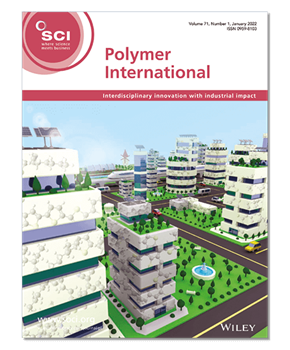Recent progress of elastomer–silica nanocomposites toward green tires: simulation and experiment
Xiu Li, Jun Liu, Zi-Jian Zheng
To read and cite the full paper, please visit:
doi.org/10.1002/pi.6454
First published: 11 September 2022
WHAT'S IT ABOUT?
The production of green tires is an important step towards reducing the carbon footprint of the automotive industry and promoting sustainable transportation. Elastomer-silica nanocomposites are a promising raw material for making green tires due to their low rolling resistance and good wet skid resistance. However, the poor dispersion of silica in rubber matrices has hindered their further enhancement. This review focuses on critical issues related to elastomer-silica nanocomposites to guide the development of high-performance green tires.
From the editor of Polymer International
Professor Timothy Long
Center Director & Professor, Biodesign Center for Sustainable Macromolecular Materials and Manufacturing
Arizona State University
Polymer International nurtures a convergence of disciplines with focus on interdisciplinary grand challenges that translate to industrial partnership and societal impact. Sustainability is a cornerstone of Polymer International, sustainability is the thread that weaves throughout the fabric of the journal. This manuscript represents the multifaceted mission of the journal, assembling expertise in elastomeric structure, composites for light weighting and dematerialisation, and seamlessly integrating computational tools with experimental validation. Forging predictive relationships to catalyse discovery in the tire industry will have an immediate impact on sustainability and circular thinking to the impact of polymeric materials on our environment.
ABSTRACT
The concern regarding increasing oil consumption that originates from the high rolling resistance of automobiles has led to the development of green tires. The key enabling technique for preparing green tires involves the utilization of elastomer–silica nanocomposites. Elastomer–silica nanocomposites usually show low rolling resistance because of the intrinsic lubrication characteristics of siloxane and the excellent elastomer-modified silica interfacial interaction, making them ideal raw materials for a green tire. It is supposed that the comprehensive properties of rolling resistance can be further improved via continually optimizing the microstructures of elastomer–silica nanocomposites. Regulating silica dispersion, understanding the interface between elastomer and silica and building the quantitative correlation between the microstructure and the static/dynamic macro-mechanical properties are crucial in designing high-performance elastomer–silica nanocomposites. This review aims to summarize the recent progress of elastomer–silica nanocomposites from the point of view of silica dispersion, the elastomer–silica interface and the microstructure–mechanical connection, combining simulation and actual experimental findings. A short conclusion and an outlook on the current limitations and possible future research directions for constructing high-performance elastomer–silica nanocomposites for low-energy green tires are also presented.
MEET THE RESEARCHER

Jun Liu
Key Laboratory of Beijing City on Preparation and Processing of Novel Polymer Materials, Beijing University of Chemical Technology, Beijing, China
In brief, what are the key properties of elastomer-silica nanocomposites, and why does this make them suitable for use in green tires?
Compared to the traditional carbon black, the incorporation of silica can endow a strong interfacial interaction between silica and elastomer, by using the silane coupling agents. This results in less interfacial slippage during dynamic deformation and much smaller hysteresis loss, which can be tailored for low fuel consumption of green tires.
Are these materials being used in other applications already, and/or do they have promising applications for other industries?
Presently, elastomer/silica nanocomposites are mainly used for automobile tires, some other applications such as seals and rubber belts are also explored.
What are the main difficulties in examining the microstructure of elastomer-silica nanocomposites?
Elastomer polymer chains are amorphous, and the loading of silica nanoparticles is always high, leading to a complicated dispersion state. Elastomer/silica nanocomposites have multiple length and time scales, making it difficult to be clearly characterised at the molecular level.
What are your key recommendations for research needed to improve the properties of green tires using elastomer-silica nanocomposites?
To optimise and choose environmentally friendly coupling agents is one aspect, and meanwhile developing energy-saving and highly efficient processing/compounding equipment is of significance.
What level of improvement do you expect to see in green tires in the next 10-15 years?
In the next 10-15 years, the development of green tires will go forward in the direction of more energy-saving, higher abrasion resistance and more excellent wet skid. Endowing green tires with rapid and room-temperature self-healing capability is another promising direction.


